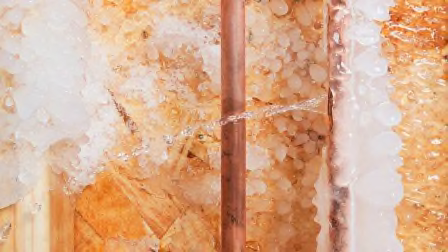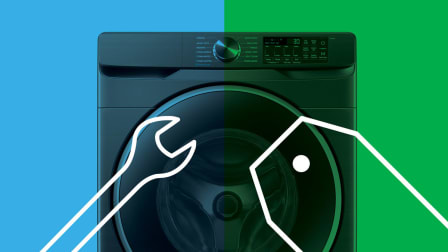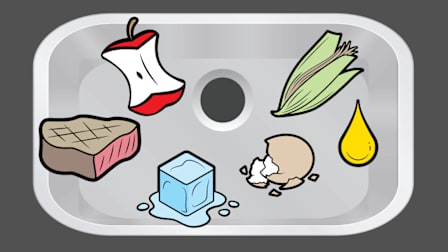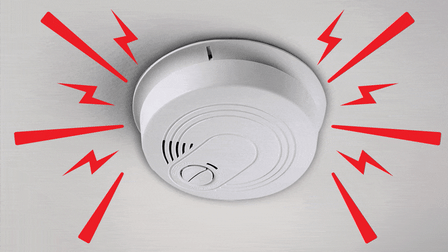Sneaky Signs of Water Damage in Your Home
Plus, the ins and outs of mold remediation
When you shop through retailer links on our site, we may earn affiliate commissions. 100% of the fees we collect are used to support our nonprofit mission. Learn more.

“Water loves to tell on itself,” Scott Johnson, president of the American Society of Home Inspectors, said in a recent interview with CR. Ain’t that the truth.
Whether the cause of water damage is a storm surge that floods your basement, a hurricane that pounds your roof and gets in through shingles you didn’t know were cracked, or a leaky faucet quietly rotting the wood behind a wall, the consequences of water gone wild always reveal themselves, eventually. Fixing water damage is often costly, time-consuming, and time-sensitive to prevent mold growth and wood rot. And the longer we wait, the worse (and more expensive) the problem can get.
- What to Know About Water Damage: 9 Signs of It in Your Home Tools to Deal With It How Quickly Mold Develops Mold Remediation vs. Mold Removal How Mold Affects Your Health
9 Signs of Water Damage in Your Home
You might spot these throughout your home if there’s a water issue.
1. Musty Smells
Your nose never lies. Johnson says musty smells (frequently detected in basements) are often the first sign of water damage. The source of a musty odor may be mold-produced compounds known as microbial volatile organic compounds (mVOCs). And if the cause of the smell isn’t water, high humidity could be another culprit, Johnson says. For the latter issue, Johnson recommends keeping a dehumidifier in those spaces and setting it at 45 percent relative humidity.
2. Creaking Floorboards
The sound of creaking floorboards isn’t just creepy—it could be a sign that you have water damage. “This is more common with soft wood floors, like pine,” Carey Vermeulen, past president of the Institute of Inspection Cleaning and Restoration Certification, tells CR. “The wood swells around the nail and allows the nail to be pulled from the subfloor. After drying, there is a slight separation between the plank and the subfloor, or the nail slightly pulls in and out of the subfloor, causing the planks to rub against each other, causing the creaking noise. Not so common with hardwood, unless it’s wet for an extended period of time—in which case it’s usually replaced.”
3. Sloping Floors
If walking from one side of your home to the other feels like riding a roller coaster, your sloping floors might benefit from a deeper investigation. Sloping floors could be a sign that you have foundation issues, and they can also indicate the presence of water damage. “Water activates mold spores,” Johnson says. “The mold spores start consuming the wood, the wood rots, and the house starts to compress.” Contacting a home inspector or structural engineer is a good place to start.
4. Doors That Don’t Latch Properly
Doors that don’t latch properly are one of those home issues that Johnson says a professional, like a home inspector, can trace back to find the culprit and ensure it isn’t water damage. When wood takes on moisture, it can swell and create problems, including misalignments such as doors that don’t latch correctly. So your door issues may not just be annoying, but could be a sign of water damage or underlying foundation issues.
5. Cracks in Walls
Cracks in the walls are one of those unsightly problems that can be a more serious sign of water damage. “All of those little weird cracks in the wall could indicate that there’s water damage below somewhere, and you have compression going on,” Johnson says. “It could mean bad workmanship. It could mean that the house has just settled.” If you’re concerned, it’s better to be safe than sorry. You can contact a home inspector or structural engineer to find the culprits behind the cracks.
6. Bubbling Wallpaper and Paint
Walls that look like they’re bubbling aren’t just aesthetically unappealing—they could be telling you that you have a water or high-humidity issue that needs to be resolved. “Wallpaper can bubble or wrinkle because it is physically wet or has been wet,” Vermeulen says. “Wallpaper can also bubble or become detached when humidity levels go beyond 70 percent for extended periods of time. Paint doesn’t usually bubble, but sometimes an oil-based or gloss finish may bubble if the Sheetrock wasn’t primed. It’s usually the Sheetrock paper that bubbles due to being wet.” In addition to running a dehumidifier in the room, try to locate the source of water damage or call a professional to help.
How to Prevent Mold From Growing in Your Bathroom
A damp environment can be a breeding ground for mold.
7. Staining and Mold on the Foundation of Your House
Water damage can affect the outside and inside of your home. It’s a good idea to routinely walk around and inspect your home’s foundation for signs of something gone awry. “On the outside of the house, it could be water staining or mold growth, depending on the climate,” Vermeulen says. One household task to be sure to keep up with is clearing your gutters (especially in the autumn when leaves begin to fall). Gutters stuffed with leaves and debris can cause water to spill over the side and pool around your foundation, and frozen water in gutters can force snow and ice onto roof shingles and cause leaks and damage.
8. A Higher Water Bill
You may not even know your home has water damage until you receive an astronomically high utility bill at the end of the month. According to the Environmental Protection Agency, “fixing easily corrected household water leaks can save homeowners about 10 percent on their water bills.” Common leaks include dripping faucets, toilet flappers, and showerheads. The EPA recommends checking your water meter before and after a 2-hour period when water isn’t being used. You probably have a leak somewhere if the meter doesn’t read exactly the same.
9. More Critters in Your Home
When water infiltrates your home, it creates the perfect conditions for pests, Jim Fredericks, board-certified entomologist and senior vice president of public affairs at the National Pest Management Association, tells CR. Some of the water-loving critters Fredericks says you may see more often that can tip you off to a problem include carpenter ants, which prefer damp wood to create their nests; fungus gnats that feed on mold and mildew; silverfish, which are drawn to warm, dark, and moist environments like your bathroom, basement, and attic; and termites, which prefer water-damaged wood and are a serious threat to your home.
Tools You Need to Deal With Water Damage
Whether the source of your water damage nightmares is a storm, flood, or leak, the principles of drying apply to every water damage situation, Vermeulen says. He adds that you’ll want to remove the excess water, encourage evaporation, dehumidify/ventilate, and control the temperature in your space.
Fortunately, some tools can help you get a head start on cleaning up a wet mess (and these come in handy even when you’ve called a professional and are waiting for an appointment). Vermeulen recommends that homeowners have a wet/dry vacuum to extract water and a home dehumidifier. He also recommends renting a professional fan that can be safely used for extended periods of time. (Be careful when using regular household fans, which Vermeulen says can overheat when used for extended periods of time and cause a fire.)
It’s helpful to have disinfectant wipes for cleanup and a water leak detector that can alert you to leaks before the problem gets out of control.
How Quickly Can Mold Develop?
Once you detect water damage in your home, the race is on to prevent mold from forming and spreading. How quickly it spreads depends on several factors, but Johnson says that without air movement, mold will colonize quickly.
According to the EPA, it is important to dry water-damaged areas and items within 24 to 48 hours to prevent mold growth. “Indoor mold growth can and should be prevented or controlled by controlling moisture indoors,” an EPA contact told CR. “If there is mold growth in your home, you must clean up the mold and fix the water problem. If you clean up the mold but don’t fix the water problem, most likely, the mold problem will come back.”
Mold Remediation vs. Mold Removal
When mold is identified in your home, you’ll likely need either mold removal or mold remediation. Mold removal is simply cleaning mold on visible surfaces. Mold remediation involves a multistep process that locates the source of moisture and mold growth and treats it to prevent a recurrence.
Let’s be clear: Unless you’re a mold remediator, you should not remediate mold yourself. The thought of calling an expert and having them decide that your house needs weeks of potentially expensive work is stressful, but not doing anything about a problem can add up to more time and money spent later. According to Vermeulen and Mark Cornelius, a member of the Institute of Inspection Cleaning, Restoration, and Certification (IICRC) board of directors, there is a standard of care for mold remediation called the ANSI/IICRC S520, which he says every mold remediator should follow. “The only acceptable way to remediate microbial growth is to remove it,” Vermeulen and Cornelius say. “Therefore, if a mold remediation contractor enters the home and simply sprays a chemical on the mold, they have not performed proper remediation.”
The experts told CR that if mold is visible on the front side of the drywall in a room, then there is probably the same amount of mold, or more, on the drywall inside the wall cavity, and that the only way to address the interior of the wall cavity is to gain access to it. The same can be true with wood flooring and cabinetry that blocks access, he says. “The majority of mold remediation projects will also need contractors to construct containment and decontamination chambers under negative pressure in order to prevent cross-contamination,” Vermeulen and Cornelius say. They urge homeowners to check to see if the contractor you are considering using is an IICRC-certified firm and employs an IICRC-certified Applied Microbial Remediation Technician (AMRT).
Of course, you’re probably wondering how much mold remediation will set you back financially. But Vermeulen and Cornelius tell CR that mold remediation project costs can vary depending on a myriad of factors, including severity and location of the mold. They encourage homeowners to review their insurance policy to see what it states about mold and mold remediation (oftentimes, mold is either capped at a certain amount or excluded altogether) and to get multiple estimates from various companies. Don’t just consider the total of the invoice, they say, but rather the scope and remediation work plan.
How Can Mold Affect Your Health?
All molds have the potential to cause health problems, and exposure to mold can cause health effects in some people, the EPA tells CR, adding that molds can produce allergens (substances that can cause allergic reactions), irritants, and in some cases, potentially toxic substances (mycotoxins). Inhaling or touching mold or mold spores may cause immediate or delayed allergic reactions in sensitive individuals, and it can cause asthma attacks in people with asthma who are allergic to mold, according to the EPA. In addition, mold exposure can irritate the eyes, skin, nose, throat, and lungs of mold-allergic and non-allergic people. Symptoms other than the allergic and irritant types are not commonly reported because of inhaling mold.
If a person is experiencing health impacts that may be due to mold exposure, it is important to consult a health professional. People may also wish to consult their state or local health department for additional resources and applicable local regulations.




















